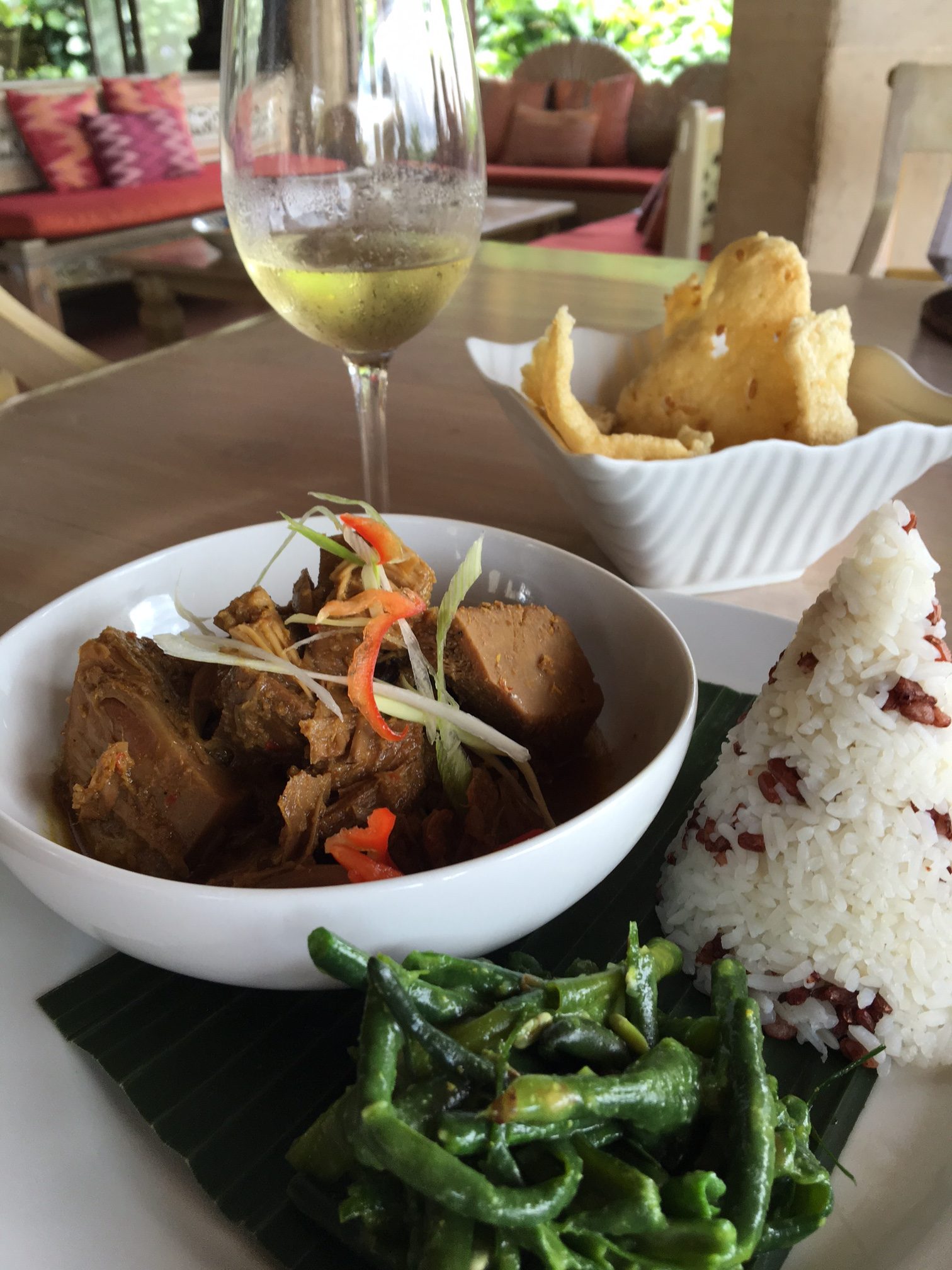Jackfruit Curry
Inroduction
About this Recipe
By: Sheridan Rogers
“To say we love jackfruit in Bali is an understatement,” says Janet De Neefe in her stunning cookbook Bali: The Food Of My Island Home (PanMacMillan Australia). The huge, green and pointy fruit shaped like an irregular watermelon has a flavour a little like artichoke when green (it sweetens to a bubblegum flavour as it ripens) and can take on other flavours when cooked in dishes such as this. So jackfruit can serve as both fruit and vegetable. “Jackfruit curry is commonly served at ceremonies because it lasts a few days, but unlike some other ceremonial dishes, this is also everyday fare. Slow-simmered with spices, the jackfruit develops a soft, chewy texture, not unlike tender beef. The optional addition of slaked or hydrated lime (calcium hydroxide) may seem unusual but is a traditional ingredient, and is also a feature of Indian and Latin American cooking, giving the curry a distinctive pinkish glow while adding a dose of calcium. Jackfruit can be found at Asian grocers, but if unavailable you can experiment with choko or green papaya. Canned jackfruit just won’t be the same.” Whilst similar to the Yogyanese gudeg (which also uses young, green jackfruit) this is the Balinese version.

Ingredients
- jackfruit 1kg
- slaked or hydrated lime (calcium hydroxide) 1 teaspoon, mixed with 1L water (optional)
- vegetable oil 3 tablespoons
- Base Ganep (see below) 4 tablespoons
- salam leaves 3
- kaffir lime leaves 3
- lemongrass stalks 2, bruised and tied together in a loose know
- pork bones 200g, or 1-2 chicken thighs on the bone (optional)
- palm sugar 2 tablespoons, grated
- candelnuts 3
- black peppercorns 1 teaspoon
- coriander seeds 2 teaspoons
- cloves 2
- sesame seeds 1/2 teaspoon
- garlic cloves 3
- red shallots 5, roughly choppeD
- long red chillies 3, seeded and roughly chopped
- small red chillies 3, roughly chopped
- fresh turmeric 2 tablespoons, peeled & chopped
- fresh galangal 5 tablespoons, peeled and chopped
- fresh ginger 1 1/2 tablespoons, peeled and chopped
- kencur 3 teaspoons, chopped (if available)
- shrimp paste 1 small slice, equivalent to 1/2 teaspoon (optional)
- nutmeg 1/2 teaspoon, freshly grated
- vegetable oil for covering
- fried shallots
Wear gloves to prepare the jackfruit to avoid being covered in the rubbery liquid which seeps out. Cut off the rind and cut the fruit, including the seeds, into bite-sized chunks. Mix the jackfruit with the lime water (if using) and leave for 10 minutes before draining. Heat the oil in a large saucepan over medium heat. Fry the base gene with the salam leaves, lime leaves and lemongrass for at least 30 seconds, stirring constantly, or until fragrant and glossy. Add the pork bones or chicken thighs (if using) and toss for a minute until just sealed. Add the jackfruit chunks and toss for another minute. Add the extra water, palm sugar and salt to taste and simmer for about one hour, until the jackfruit is tender. Add more water if necessary. If you want a creamy finish, add 3 tablespoons coconut milk and simmer for another minute or two. Season to taste with sea salt, adjusting with extra palm sugar (&/or salt) if needed. Serve garnished with fried shallots. For the Base Genep (Complete Spice Mix): Grind the candlenuts, peppercorns, coriander seeds, cloves and sesame seeds to a powder in a large mortar. Add the remaining ingredients and pound to a smooth paste (alternatively you can blitz the dry ingredients in a coffee grinder, then transfer to a blender or food processor, add the remixing ingredients and blitz to a paste, adding a splash of water to get the mixture moving if needed). The base genep should be fragrant, peppery and golden yellow. Spoon into a jar, cover with a thick film of oil and store in the refrigerator where it will keep for at least a week. Makes 3/4 cup. Note: Base gene is a multi-layered spice paste which is used in many Balinese dishes, from elaborate ceremonial foods to everyday fare. It contains all the spices precious to the Balinese and virtually every ingredient boasts healing properties. Janet admits the list of ingredients is rather daunting but says it’s not difficult to make: “it is even therapeutic and uplifting (cooking is as much about feeding the soul as it is about filling the tummy).” Salam leaves come from the cassia family and are often described as Indonesian bay leaf. Indonesia shrimp paste is called tears, and like Malaysian belachan is sold in dense block to be cut with a knife.
